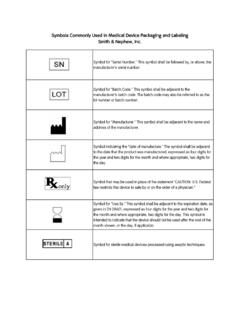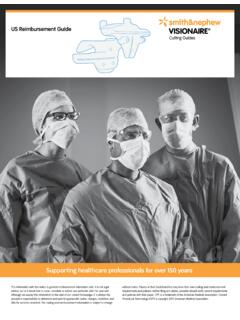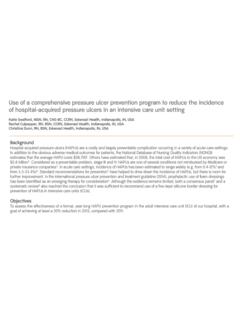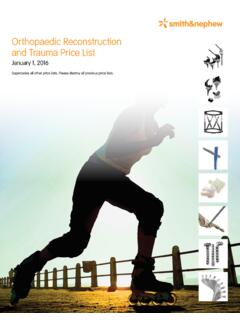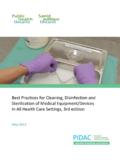Transcription of Instructions for care, maintenance, cleaning and ...
1 Instructions for care, maintenance, cleaning and sterilization of smith & nephew orthopaedic devicesTable of contents Purpose ..2 Scope ..2 Important information/recommendations for use ..3 Recommended cleaning Instructions ..4 Warnings Limitations of cleaning Instructions Limitations of reprocessing Preparation at the point of use prior to processing Preparation for cleaning Overview of product groups for reusable device cleaning Definition of product groups Recommended cleaning procedures ..6 Recommended cleaning procedures Manual cleaning - Manual cleaning procedure for devices WITHOUT challenging design features- Manual cleaning procedure for flexible reamer devices- Manual cleaning for powered instruments- Manual cleaning for containment devices- Manual cleaning procedure for non-critical devices/equipment - Verifying cleaning Recommended cleaning procedures Automatic washing and thermal disinfecting - Automatic washing procedure for devices WITHOUT challenging design features - Automatic washing procedure for devices WITH challenging design features - Automatic washing procedure for Flex Reamer Devices - Automatic washing cycle - Steps and parameters - Thermal disinfection parameters - Verifying cleaning Inspection and function testing Maintenance and care
2 Storage Further information Contact information Recommended sterilization Instructions ..11 Warnings Limitations of reprocessing Updates for sterilization Implants Reusable devices Containment devices Preparation for sterilization Recommended sterilization parameters Recommended sterilization methods for device types Storage Further information Important sterilization notes Contact information References ..152 PurposeThis document was prepared to provide Instructions for the care, maintenance, cleaning and sterilization of the medical devices produced by the Orthopaedics Business of smith & nephew , Inc. These methods were developed using standard equipment and practices common to health care facilities. Validation testing to support these Instructions was based on recognized guidelines and standards for reusable devices and containment devices from the following organizations: American National Standards Institute (ANSI)Association for the Advancement of medical Instrumentation (AAMI)Association of Operating Room Nurses (AORN)German Instrument Working Group (AKI) Arbeitskreis Instrumenten-AufbereitungHealth CanadaInternational Standards Organization (ISO)International Association of Healthcare Central Service Material Management (IAHCSMM)World Health Organization (WHO)UK Department of HealthAustralian/New Zealand StandardScopeThese Instructions apply to all instruments that are sold by smith & nephew Orthopaedics for reuse.
3 These instruction also apply to single use devices that are placed in containment devices prior to sterilization ( plates, nails, screws, pins and wires). This includes single use devices that are packaged sterile but are removed from its sterile packaging and placed in containment devices. 3 Detergents Low foaming detergents with a pH range between and are recommended. Detergents with a pH outside this range can have an adverse effect or be damaging to some instruments and containment devices. Enzymatic detergents aid in the removal of organic soil such as should be used at the concentration and temperature recommended by the detergent manufacturer. There are some alkaline detergents that have been formulated to be safe for reprocessing medical devices. Refer to the manufacturer s limitations and warnings for information concerning specific materials that are adversely affected by the quality of water should be carefully considered for use in cleaning reusable devices.
4 Water hardness is a concern because deposits left on medical devices may result in ineffective cleaning and sterilization . Final rinsing should be carried out using demineralized washer/disinfector Washer-disinfectors are not only used to clean devices, but also to provide intermediate to high level disinfection with a hot water rinse. cleaning is dependent upon thorough coverage of the devices and the force of the water spray. Therefore, all sections of the device must be accessible for ease of cleaning and penetration of cleaning agents. The automatic washer/disinfector equipment should be operated following the manufacturer s Instructions for cleaning toolsHospital tools necessary for manual cleaning include: surgical scrub brushes, chenille pipe cleaners, soft low linting cloths, cotton tip applicators, and several size and length not use abrasive cleaning tools ( scouring pads or metal brushes).
5 cleaning tools must be cleaned and inspected between use. Cloths should be clean and lint free and changed frequently. Brushes should be clean. Discard worn brushes and disposable cleaning precautionsPersonal Protective Equipment (PPE) should be worn when handling or working with contaminated or potentially contaminated devices. PPE includes: gown, mask, goggles or face shield and shoe precautions should be observed by all hospital personnel that work with contaminated or potentially contaminated devices. Caution should be exercised when handling devices with sharp points or cutting Precautions: Universal precautions are standards of infection control practices designed to reduce the risk of transmission of bloodborne Indicator (CI): Test system that reveals change in one or more pre-defined process variables based on a chemical or physical change resulting from exposure to a process.
6 CIs assist in the detection of potential sterilization failures that could result from incorrect packaging, incorrect loading of the sterilizer, or sterilizer malfunctions. The pass response of a CI does not prove that the item monitored by the indicator is Indicator (BI): Test system containing viable microorganisms providing a defined resistance to a specified sterilization : A small flip top case that contains multiple small implants ( screws, plates, etc).Containment Device: A reusable rigid sterilization container, instrument case/cassette, caddy or organizing tray and any reusable accessories for use in healthcare facilities for the purpose of containing reusable medical devices for information/recommendations for use4 Recommended cleaning instructionsCleaning is the single most important step in preparing a device for reuse.
7 Effective cleaning must be carried out to achieve proper disinfection/ sterilization . Thorough cleaning and rinsing are vital to reprocessing reusable medical devices. Also, thorough rinsing is important for the removal of any residual cleaning agents from the medical devices. The purpose of cleaning and rinsing is to remove all adherent visible soil and to reduce the number of particulates, microorganisms, and pyrogens. The recommended cleaning Instructions in this document include both manual and automatic washing/disinfection procedures. While manual cleaning is the most universal method of cleaning , automatic washing is preferred. The cleaning processes presented in this brochure have been validated. Other methods of cleaning may be suitable but must be validated by the user of the It is the responsibility of the user to ensure that the cleaning process is performed following these procedures to achieve the desired procedures do not apply to single-use devices.
8 smith & nephew , Inc. has not validated the cleaning of single use devices and does not support the reuse of single-use ultrasonic cleaning , the enzymatic detergent solution should be changed before it becomes heavily soiled so that effective cleaning is not electronic devices cannot be submerged during cleaning and could sustain permanent damage as a result of submersion. Check the Instructions for Use for information on submersion of electronics. Do not sonicate powered cleaning should be performed in a manner designed to minimize exposure to bloodborne pathogens. Manual cleaning should be done while the instrument is of cleaning instructionsThese recommended procedures are intended as a general guide for cleaning of medical devices. Some devices are labeled with more specific of reprocessing Repeated reprocessing of reusable medical devices has minimal effect on the devices.
9 End of life is normally determined by wear and damage due to at the point of use prior to processingKeep instruments moist after use to prevent soil from drying on Universal Precautions for handling and transporting contaminated instruments to the designated cleaning area. Contaminated instruments should be transported to the area for cleaning in a way that avoids contamination of personnel and to cleaning , gross soil should be removed from the surfaces, crevices, mating surfaces, cannulas, joints and all other hard-to-clean design features. Dried on soil is difficult and sometimes impossible to remove with automatic should be cleaned as soon as possible after use to prevent blood from drying on the devices. (A four-hour dry time is used for cleaning validations of smith & nephew Orthopaedics reusable devices.)
10 Preparation for cleaningDevices capable of disassembly must be disassembled prior to cleaning Note If you have questions concerning the disassembly of any smith & nephew Or-thopaedics device, contact your smith & nephew sales representative or the Quality Department (see Contact information ).Overview of product groups for reusable device cleaningCleaning of reusable devices is dependent upon product design features. The cleaning methods for smith & nephew reusable devices are based on product groups that have design features that present a similar challenge to Overview of product groups for reusable device cleaning (continued)Device categories for cleaning :- Devices WITHOUT challenging design features- Devices WITH challenging design features- Flexible reamers- Powered devices- Containment devices- Noncritical devices/equipmentDefinition of product groupsDevices WITHOUT challenging design features: Includes all instruments that do not have design features that present a challenge to cleaning by the smith & nephew recommended cleaning procedure.
